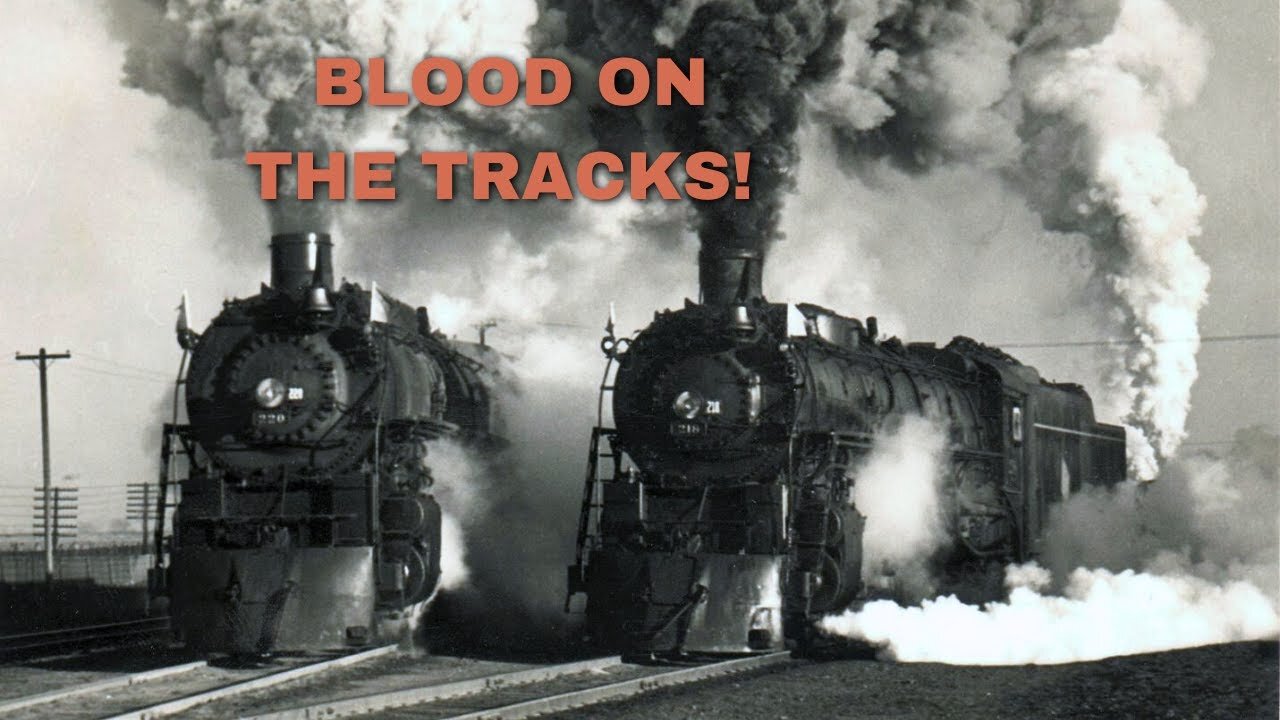Premium Only Content

BLOOD ON THE TRACKS! || HORSE CACTUS MUSIC
BLOOD ON THE TRACKS! || HORSE CACTUS MUSIC
Among other subjects, this song {as performed here by Nashville's epic and notorious Mr. Ron Wallace} depicts an epochal historic event in the formation of these United States of America. The original salute to industry in this work occurred at Promontory Point, Utah, site of the dramatic completion, on 10 May 1869, of the first transcontinental railroad linking the Union Pacific on the east and the Central Pacific on the west.
A crowd gathered to witness the final ceremonies, including many Great Plains Indians, who lurked just on the horizon. To mark the site, a ceremonial “Golden Spike” was driven, soon replaced with a steel one when the first of a series of memorials was erected. For years after the ceremony, nomadic tribes in the area made it a point to desecrate the monument at every crossing, be it with urine or a more inelegant offering.
William Frederick "Buffalo Bill" Cody, using his .50 caliber Springfield rifle, was hired by Kansas Pacific Railroad to kill buffalo to feed hundreds of railroad workers hired for laying track. Although killing bison to force Native Americans off the Plains was never explicit U.S. political policy, the government endorsed it. It is widely believed that during this period of time Ulysses S. Grant gave an unofficial order to exterminate as many buffalo as possible to starve out the Native Americans who were hanging on to their Tribal lands all across the Great Plains, forcing these original Americans onto stipulated reservations.
Texas legislators offered a bill to protect the species. Gen Philip Sheridan opposed it: ”These men have done more in the last two years, and will do more in the next year, to settle the vexed Indian question, than the entire regular army has done in the last forty years." His intention was to starve out Great Plains Native Americans.
Some individual “hunters” were said to have killed over five thousand animals each using their .50 caliber Sharps and Spencer rifles. Said Sheridan, “...for a lasting peace, let them kill, skin and sell until the buffaloes are exterminated. Then your prairies can be covered with speckled cattle.” Always a money angle, even back then.
A calculated thirty-million magnificent American Bison were left to rot behind the trains and Army troop movements crossing those prairies. By the end of the 19th century, only 300 buffalo were left in the wild of the US continent.
An estimated 11,000 to 15,000 Chinese laborers helped build the transcontinental railroad. Chinese workers at one point may have constituted close to 90 percent of the Central Pacific workforce. As a group, they were known for performing efficient high-quality work and for adhering to long, rigorous shifts without complaint.
A far darker account of these laborers and their work has been hidden and forgotten in the convenient dustbin of history.
-
 1:01:57
1:01:57
BonginoReport
3 hours agoTampon Tim’s Daughter: “Trump Would Have Deported Jesus” - Nightly Scroll w/ Hayley Caronia (Ep.31)
64.5K67 -
 LIVE
LIVE
Kim Iversen
3 hours agoEXPOSED: How Joe Biden Turned America into the Child Trafficking Capital of the World
3,454 watching -
 LIVE
LIVE
Sarah Westall
1 hour agoIs the Fight against China Real? Military Industrial Complex vs China w/ Dr. Rebecca Grant
619 watching -
 1:50:18
1:50:18
vivafrei
5 hours agoInterview with Nick Rekieta, Meghan Murphy! Liberals Go Fingers Up! Democrats Suicidal Empathy! AND MORE! Viva Frei
120K63 -
 54:58
54:58
Candace Show Podcast
4 hours agoWOAH! Shannon Sharpe Names His ‘Jane Doe’ Accuser. Is This The End Of #Metoo? | Candace Ep 180
79.6K59 -
 1:31:11
1:31:11
Redacted News
4 hours agoSomething BIG is happening at Trump's Pentagon and it's not good for peace | Redacted News
83.2K104 -
 LIVE
LIVE
LFA TV
8 hours agoDems Fight Harder for Illegals Than for Citizens | TRUMPET DAILY 4.22.25 7PM
295 watching -
 LIVE
LIVE
RalliedLIVE
4 hours ago $1.36 earnedWarzone Wins All Night w/ Ral
176 watching -
 LIVE
LIVE
Geeks + Gamers
2 hours agoTuesday Night's Main Event
408 watching -
 57:03
57:03
BEK TV
20 hours agoTHE GREAT TAKING: HOW GLOBAL ELITES PLAN TO STRIP YOU OF YOUR PROPERTY SAVINGS
12.8K2